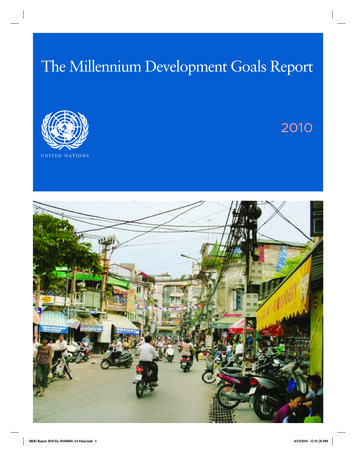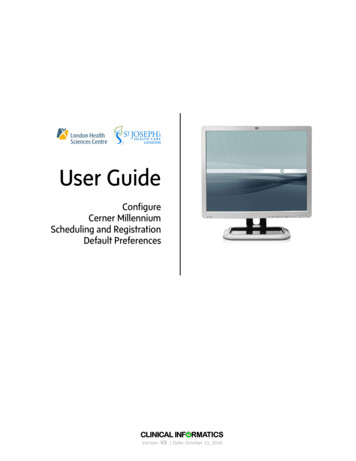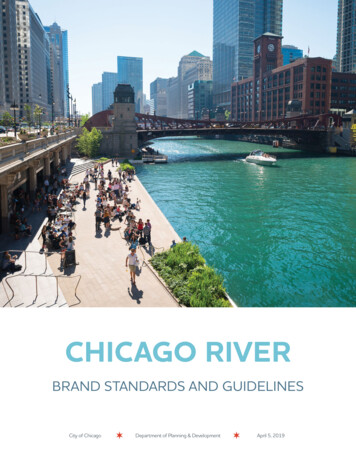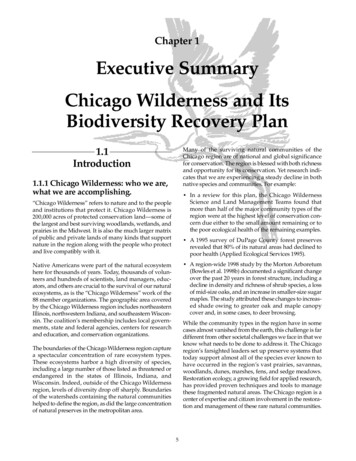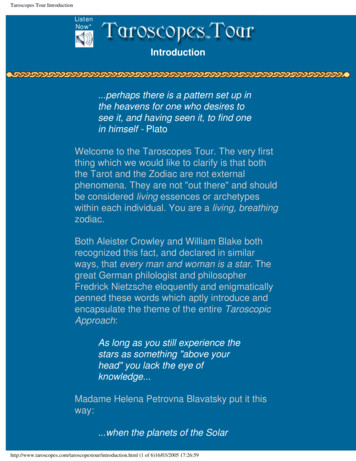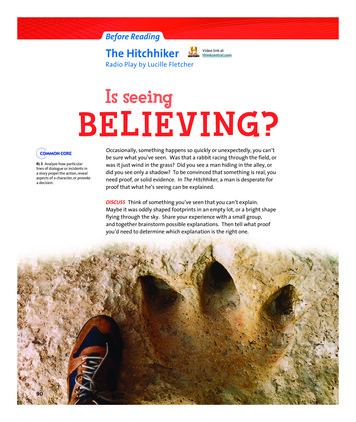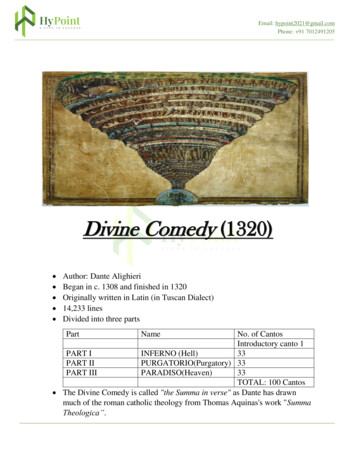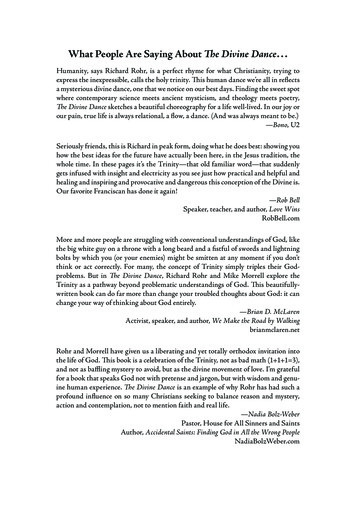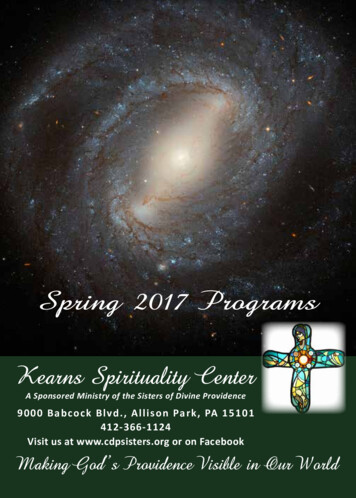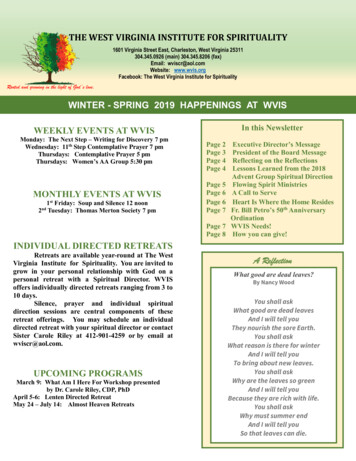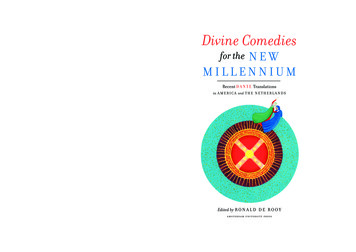
Transcription
Amsterdam. This volume contains articles by Paolo Cherchi (University ofChicago, Università di Ferrara), Robert Hollander (Princeton University),Jean Hollander, Pieter de Meijer (University of Amsterdam), Paul van Heck(University of Leiden), and Ronald de Rooy (University of Amsterdam).ISBN 90-5356-632-5www.aup.nla m s t e r da m u n i v e r s i t y p r e s sDivine Comedies for the N E W M I L L E N N I U MR O N A L D D E R O O Y lectures in Italian literature at the University ofR O N A L D D E R O O Y ( ed.)Dante’s intranslatability paradoxically causes a steadyflux of translations, overwhelming in America,much more modest in the Netherlands. However,the tiny Netherlands witnessed a remarkableboom of Dante translations around the year 2000:within a short period seven cantiche were translatedby Dutchmen and seven by Americans. This historicmoment gave rise to a seminar about these recenttranslations, and about the traditions of translating Dantein both nations. The American and Dutch Divine Comedies discussed in thisvolume are important landmarks in a long tradition of making Dante’s workaccessible to non-Italian readers in both countries. On this already crowdedstage, however, every newcomer inevitably makes statements about howDante’s masterpiece should be read: as a poem, as a scholarly text or as ascholarly poem? The old polarization between the fearless (at times reckless)‘poetical’ translators and the more cautious ‘academic’ translators is verymuch alive, and the choice seems one between compromise and confrontation,between caution and courage.Divine Comediesfor the N E WMILLENNIUMRecent D A N T E Translationsin A M E R I C A and T H E N E T H E R L A N D SEdited by R O N A L D D E R O O Ya m s t e r da m u n i v e r s i t y p r e s s9 789053 566329
Divine Comedies(dddd)04-01-200421:50Pagina 1Divine Comedies for the New Millennium
Divine Comedies(dddd)04-01-200421:50Pagina 2
Divine Comedies(dddd)04-01-200421:50Pagina 3Divine Comedies for the New MillenniumRecent Dante Translations in America and the NetherlandsEdited by Ronald de RooyAmsterdam University Press
Divine Comedies(dddd)04-01-200421:50Pagina 4With special thanks to the Istituto Italiano di Cultura per i Paesi Bassi (Amsterdam) and theAmsterdam committee of the Società Dante Alighieri for their financial contributions to therealization of this project.Cover design: Studio Jan de Boer bno, AmsterdamLay out: Paul Boyer, AmsterdamCover illustration: Paradiso 17. Dante and Beatrice are leaving the Heaven of Mars, where Dantehas met his ancestor Cacciaguida. (15 10 cm) Monika BeisnerAll illustrations Monika Beisnerisbn 90 5356 732 5nur 630 Amsterdam University Press, Amsterdam, 2003All rights reserved. Without limiting the rights under copyright reserved above, no part of thisbook may be reproduced, stored in or introduced into a retrieval system, or transmitted, in anyform or by any means (electronic, mechanical, photocopying, recording or otherwise) withoutthe written permission of both the copyright owner and the author of the book.
Divine Comedies(dddd)04-01-200421:50Pagina 5Table of ContentsintroductionRonald de Rooy7Divine Comedies for the New Millennium.Humbleness and HubrisPaolo CherchiThe Translations of Dante’s Comedy in America23Robert HollanderTranslating Dante into English Again and Again43Jean Hollander‘Getting Just a Small Part of it Right’49Ronald de RooyThe Poet Translated by American Poets.In Search of the Perfect ‘Trasmutazione Musaica’55Paul van HeckCiò che potea la lingua nostra.75One Hundred and More Years of Dante Translationsinto DutchPieter de MeijerTranslating Dante’s Translations101notes115about the contributors133selected bibliography of american and dutch dante translations135index of names141
Divine Comedies(dddd)04-01-200421:50Pagina 6
Divine Comedies(dddd)04-01-200421:50Pagina 7Divine Comedies for the New Millennium.Humbleness and Hubrisronald de rooyDante in America It was not that surprising that in the United States of America Dante’s DivineComedy received a lot of extra attention from translators in the years before thejubilee 2000, a ‘magic’ year because of the 700th anniversary of Dante’s voyagethrough the otherworld. America, of course, could already boast a strong traditionof Dante translations. At the beginning of the nineteenth century, the popularEnglish Dante translation by Henry Francis Cary was an important instrument forintroducing Dante in America.1 The American tradition really began with ThomasWilliam Parsons2 and continued with the first American ‘dantisti’ in Boston atHarvard College, reaching a first peak with the still famous translation publishedby Henry Wadsworth Longfellow in 1867.3 Since then, Dante has been translatedinto English ‘again and again’ (to quote the title of Robert Hollander’s contribution to this volume), resulting in a steady flux of English canticles that seems tofollow, someone once calculated, an almost biological rhythm: approximatelyevery nine months a new English canticle is born, so to speak.4What’s more, this steady flow of ‘Englished’ Comedies has been accompaniedfrom its very beginning by an extremely powerful and influential tradition ofDante studies. In the second half of the nineteenth century, Harvard College wasa fertile breeding ground not only for Dante translations, but also for Dantestudies: to remind us of the importance of this tradition, we need only mentionfamous scholars like Henry Wadsworth Longfellow, Charles Eliot Norton, JamesRussell Lowell, Charles Grandgent, and George Santayana. As is generally known,in the course of the twentieth century many other American scholars producedcountless, truly indispensable contributions to the interpretation of Dante’s works.Apart from being repeatedly translated and eminently studied, Dante’sCommedia has also been a steady and profound intertextual presence in AngloAmerican prose and poetry. Renowned and diverse twentieth-century authorsand poets like Joseph Conrad, James Joyce, T.S. Eliot, Ezra Pound, W.H. Auden,Malcolm Lowry, Robert Lowell, Seamus Heaney, W.S. Merwin, Derek Walcott– to mention only a few of the better known names – have all been writing (andsometimes even living) for shorter or longer periods under Dante’s spell.5Dante’s critical, creative, and translational fortuna in modern America hasbeen, in one word, overwhelming.7
Divine Comedies(dddd)04-01-200421:50Pagina 8 and in the NetherlandsIt is only logical that Dante’s critical and literary reception has been much moresmall-scale and modest in a tiny country like the Netherlands. Throughout thenineteenth and twentieth centuries, the Netherlands has produced a reasonablenumber of Dante translations, but their total constitutes no more than approximately one-fifth of the overpowering Anglo-American production. It was surprising,however, that even the Netherlands with its modest tradition of Dante studiesand translations experienced a genuine boom in Dante translations in the periodaround the year 2000. In fact, when adopting a specific and, I admit, slightlynationalistic point of view and focusing only on the period 1996-2003, we see akind of balance between the number of Dante translations in the huge USA andthat in the tiny Netherlands.In these years around 2000, in fact, no less than seven canticles were published inDutch (i.e. two entire Comedies and one Inferno) versus nine canticles in English (i.e.one entire Comedy, four Inferno’s, and two Purgatorio’s). The table below contains allDante translations in the USA and in the Netherlands in the last twenty 98199920002001200220031996-20028USAcanticlesMark MusaAllen MandelbaumC. H. SissonNicholas Kilmer [Inf.]Tom Phillips [Inf.]James Finn CotterSteve Ellis [Inf.]Robert Pinsky [Inf.]James Torrens [Par.]Peter DaleRobert Durling [Inf.]Elio Zappulla [Inf.]3331133W.S. Merwin [Purg.]Robert & JeanHollander [Inf.]Michael Palma [Inf.]Anthony Esolen [Inf.]Robert & JeanHollander [Purg.]Robert Durling [Purg.]NetherlandscanticlesFrans van Dooren3Jacques Janssen [Inf.]Ike Cialona & PeterVerstegenRob Brouwer [Inf.]Rob Brouwer [Purg.]Rob Brouwer [Par.]1441212112(10)6 Inf.2 Purg.2 Par.(7)3 Inf.2 Purg.2 Par.ronald de rooy
Divine Comedies(dddd)04-01-200421:50Pagina 9As is clear from this table,6 in the last six years (1996-2002) the numerical differencebetween the USA and the Netherlands has suddenly become very small: the USA‘prevails’ by merely three Inferno’s. However, if we do not include the translationof the entire Comedy published by the English poet Peter Dale, the Netherlandsand the USA draw even at 7 to 7.Of course, as becomes equally clear from the upper rows in the same table,this kind of mathematics will only work in a very short period around the year2000, but it shows nonetheless how incredibly flourishing the most recent yearshave been for Dutch Dante translations. While the American increase of Dantetranslations around year 2000 constituted no more than a slight increase in a longand already productive tradition, in the Netherlands we truly witnessed an upsurgeof Dante’s fortuna.This fortunate and historic moment in Dutch Dante studies, unique in the wholeworld, gave rise to a seminar about the recent Dante translations in the USA andin the Netherlands. It seemed important to record this historic moment somehowbefore the USA would inevitably take back its control of the situation.7 This seminarwas an interesting opportunity for American and Dutch Italianists to compare thetwentieth-century traditions of Dante translations in these two nations and topresent several critical and comparative analyses of the most recent American andDutch translations. The results have been brought together in this volume.The contributions of Paolo Cherchi and Paul van Heck offer valuable insightinto the history of American and Dutch Dante translations. For the USA, PaoloCherchi discusses the most important highlights of Dante’s American ‘pilgrimage’,from the first American translator, the dentist Thomas William Parsons, up to oneof the most recent, the ‘poet laureate’ Robert Pinsky. Cherchi pays due attention tothe older translations as well, because several of them are still significant referencepoints for modern translators. Cherchi discusses the merits of the famous Dantetranslation by Henry Wadsworth Longfellow, whose Inferno has very recently beenreprinted.8 Particularly, he compares some beautiful Paradiso excerpts fromLongfellow’s version with the first important prose translation by Charles EliotNorton. Roughly speaking, the first half of the twentieth century is dominated byvarious translational experiments, and by the slow transition from a RomanticVictorian perspective on translating to a more ‘formalistic’ concept and approach.The modernist poets T.S. Eliot and Ezra Pound played a key role in this processtowards a formalist aesthetic. A real achievement in this context was John Ciardi’s‘transposition’ of Dante’s Comedy, a recreation in which the translator tries toconvey some idea of the living language of the original text. Cherchi’s chapter alsofocusses on the most influential translations from the last fifty years – especiallythose by Charles Singleton, Mark Musa, Allen Mandelbaum, and Robert Pinsky –thus compensating for the shortage of studies about this period.divine comedies for the new millennium9
Divine Comedies(dddd)04-01-200421:50Pagina 10For the Netherlands, Paul van Heck has described the history of all Dutchtranslations of the Comedy, a tradition which up to now comprises fifteen entireComedies and three Inferno’s. In one of the appendices of his article, Van Heck hasbrought together eighteen different Dutch versions of the famous simile of thepeasant and the fireflies with which Dante conveys his first visual impression ofthe bolgia of the false counselors (Inf. 26, 25-33). Van Heck’s important survey of theeighteen translations of Dante’s Comedy focuses especially on their translationalstrategies, but interestingly also on many of their paratextual aspects: the number ofvolumes and pages, the format of the book, the number of its editions, the aestheticquality of the edition, and the scholarly quality of the edition (which, amongother things, can be measured by the presence or absence of the Italian text, thepresence or absence of a foreword, a general introduction, an afterword, theextent and depth of the commentary, etc.). With this last analysis, Van Heckdemonstrates that an ‘accurate description of the paratext amounts to a descriptionof the way a text presents itself in literary society and of the welcome it receives’.In the final part of his article, Van Heck takes the reader round a portrait gallery,showing especially the completely forgotten makers of some of these DutchDante translations.The other four articles in this volume focus primarily on the characteristicsand qualities of the most recent Dante translations. Paolo Cherchi ends hisAmerican chronological survey by merely referring to one of the most interestingAmerican Dante projects in recent years, namely the free verse translation byRobert and Jean Hollander.In this volume, both Robert and Jean Hollander share their views on translatingDante in general and on their own translation in particular. The Hollanders’translation was born out of a collaboration between a renowned scientist and agifted poetess, ‘the fruit of wedding Philology with Poetry,’ as Paolo Cherchi putit. The project started as a revision and modernization by Robert Hollander ofthe prose translation by John D. Sinclair,9 a new version that he needed for hisprestigious Princeton Dante Project, one of the major Dante sites on theInternet.10 One day Jean was looking over her husband’s shoulder at what he wasdoing, and her judgment was devastating: ‘What is it? It’s awful,’ she said.According to Jean, this text was nothing less than ‘unsayable’, non-poetical to thedegree of being literally unspeakable. Within two days, Jean transformed thefirst Sinclair-Hollander canto into a poetical text, and that is how their fruitfulcollaboration began: Robert Hollander took responsibility for the accuracy of thetranslation, and Jean Hollander had to make sure that ‘it sounds like Englishverse’. The note that precedes Robert Hollander’s scholarly introduction readslike a sort of confession in which the Hollanders are extremely clear about theirtranslational strategy and about the goals of their translation:10ronald de rooy
Divine Comedies(dddd)04-01-200421:50Pagina 11‘Reader, this is an honest book,’ Montaigne says this of his Essays. We would like to saythe same of this translation. We have tried to bring Dante into our English withoutbeing led into the temptation of making the translation sound better than the originalallows.11The two translators, who strike a very modest attitude towards Dante’s text, invitetheir readers to form an opinion about their translation by comparing it to theoriginal that is printed, and that is how it ought to be, a fronte:The result may be judged by all who know him in his own idiom. This is not Dante,but an approximation of what he might authorize had he been looking over ourshoulders, listening to our at times ferocious arguments. We could go on improvingthis effort as long as we live. We hope that as much as we have accomplished will findan understanding ear and heart among those who know the real thing. Every translationbegins and ends in failure. To the degree that we have been able to preserve some ofthe beauty and power of the original, we have failed the less.12The couple is very honest in expressing their at times great debt towards the prosetranslation by John D. Sinclair, and finally they are very clear about the aim oftheir efforts:Our goal has been to offer a clear translation, even of unclear passages. We have alsotried to be as compact as possible – not an easy task, either. It is our hope that thereader will find this translation a helpful bridge to the untranslatable magnificence ofDante’s poem.13They also have a similar crystal-clear opinion as to their choice of expressivemeans: in a chat published on the Internet, they say they avoided a rhyming orterza rima translation because according to them the contents of the originalshould prevail:We find that the loss that occurs in finding rhymes so forces the sense that it is betterto surrender on that front and try to be most faithful to the shadings of sense in theoriginal. People disagree about this, but that is where we stand.14Nonetheless, it is remarkable that many recent American translations are made bypoets and writers. It is even more remarkable that many recent translations by poetsare written in Dante’s original metre, the famous terza rima, which is notorious forits untranslatability. I will focus on this ‘poetical’ category of modern AmericanDante translations, and in particular on the poets/translators Robert Pinsky, RichardWilbur, Peter Dale and Michael Palma in my own contribution to this volume.divine comedies for the new millennium11
Divine Comedies(dddd)04-01-200421:50Pagina 12In the Netherlands, on the other hand, poets and writers do not play animportant role in modern Dante translations. The last poet to have translated theComedy in rhyming tercets in Dutch was Albert Verwey, and this translation datesback to 1923.15 The makers of the twentieth-century Dutch Comedies are mostlyteachers of the classics, priests, and professional translators. In his contributionabout the most recent Dutch translations, Pieter de Meijer focuses on a kind of‘mise en abyme’-effect: translators of the Divine Comedy are, in fact, translatingthe text of a poet who has already proved to be an excellent translator in his ownright. In the Divine Comedy, Dante frequently translates for example some of hisclassics, the Bible, or liturgical texts. In analyzing how the most recent Dutchtranslators – Jacques Janssen, Rob Brouwer, Ike Cialona and Peter Verstegen –have dealt with this specific aspect, De Meijer manages to bring out some of theessential merits but also some imperfections of their translations.Newcomers on a Crowded StageThe American and Dutch Divine Comedies discussed in this volume are first of allimportant landmarks in two different traditions of making Dante’s work accessibleto non-Italian readers. At the same time, however, they are not intended exclusivelyas a mere slip road to Dante’s masterpiece: these translations were made whennumerous others were already available in Dutch and English. Therefore, on thisalready crowded stage every newcomer inevitably makes (direct or indirect) statements about how Dante’s masterpiece should be read: as a poem, as a scholarlyor philosophical treatise, or as a learned philosophical poem? Regardless of thetranslators’ intentions, it is necessary and illuminating to analyze and comparethe effective results of these translations with regard to semantic faithfulness, toneand poeticality, in order to get some idea as to the directions in which theAmerican and Dutch traditions are moving.As we will see in the course of this volume, the already mentioned numericalequilibrium between the USA and the Netherlands is also reflected in a series ofsimilar choices from the spectrum of possible translational strategies by Americanand Dutch translators, and in similar developments and trends. Roughly speaking,there seems to be a tendency from soberly ‘colloquial’ or soberly ‘academic’ prosetranslations (say the Inferno by Robert Durling in the USA and that by JacquesJanssen in the Netherlands) towards more poetical translations in free or blankverse, and also in terza rima.As regards prose translations, it should be remembered that in the last threedecades of the twentieth century there were several very popular and successfulprose translations. In particular, we must mention the famous American versionby Charles Singleton (1970-1975)16 and the extremely popular Dutch version byFrans van Dooren (1987).17 It is interesting to note, however, that these two prose12ronald de rooy
Divine Comedies(dddd)04-01-200421:50Pagina 13versions form exact opposites in their translational strategy. Singleton adopts asober, simple and literal style throughout his whole Comedy, thus giving themaximum priority to his thorough scholarly commentary and, paradoxically, to theItalian original that is printed a fronte. Van Dooren, on the other hand, constantlytends towards a more paraphrastic translation, ‘filling in’ the blanks and illuminatingthe dark spots of Dante’s text.18Judging from the most recent translations in the USA and the Netherlands,however, prose seems to have become somewhat outdated. It is significant in thisrespect that the most recent prose translators, Robert Durling and JacquesJanssen, seem to cover up their use of prose by using a rather effective and morepoetical lay out in which one tercet of the original corresponds to one paragraphin the translation.Among the recent poetical translations, we can distinguish between (1) essentially poetical and ‘creative’ translations, are often in terza rima, and (2) free orblank verse translations that try to strike a happy medium between poeticalityand semantic faithfulness.Among recent poetical and ‘creative’ translations we should mention at leastthose by Robert Pinsky (1994), Peter Dale (1996), W.S. Merwin (2000), andMichael Palma (2002) in the USA,19 and in the Netherlands that by Ike Cialonaand Peter Verstegen (2000).20The most significant recent free verse translation is certainly that by Robertand Jean Hollander (Inferno 2000, Purgatorio 2003),21 while Rob Brouwer(Inferno 2000, Purgatorio 2001, Paradiso 2002) has enriched the Netherlands witha beautiful blank verse translation.22From Cautious to CourageousW.S. Merwin has asserted that every single translation of Dante’s Comedy ‘had adimension of impossibility’.23 Strictly speaking, the Comedy is untranslatable, andthis might very well be the main reason why the flow of new Dante translationsnever stops. On the other hand, it seems that Dante translations have reachedsome kind of crossroads, at which every new translator has to make an importantand decisive choice. The old polarization between the fearless (at times reckless)‘poetical’ translators and the more cautious ‘academic’ translators seems to be verymuch alive. As I have said before, prose translations, although still popular in the1970s and 1980s, seem to have become outdated. Now the choice is ratherbetween compromise or confrontation, between caution and courage, betweenfree or blank verse and rhyming verse. And there certainly seems to be a mysteriouspressure on present-day translators to follow Dante’s footsteps more closely,rhyming like he does, repeating his miracle.We could compare this situation to the delicate moment in Dante’s story ofUlisse, when the courageous voyager hero tries to convince his loyal but moredivine comedies for the new millennium13
Divine Comedies(dddd)04-01-200421:50Pagina 14cautious companions to move on, to explore the unknown, to try new ways Ulisse could in this respect be seen as a figure of the fearless terza rima translator,while his hesitant companions and Dante himself might be seen as the morecautious and often more modest verse translators. Dante has immortalized thismoment of choice in the three famous tercets of Ulisse’s passionate plea:‘O frati,’ dissi, ‘che per cento miliaperigli siete giunti a l’occidente,a questa tanto picciola vigiliad’i nostri sensi ch’è del rimanentenon vogliate negar l’esperïenza,di retro al sol, del mondo sanza gente.Considerate la vostra semenza:fatti non foste a viver come bruti,ma per seguir virtute e canoscenza.’(Inf. 26, 112-120) [Ill. 4, Inferno 26]In the remainder of this introduction, I will examine several American andDutch translations of this superb fragment. This survey will allow me to introducebriefly the most important stylistic characteristics of these Divine Comedies forthe new millennium, and at the same time it will serve as an illustration of a cleartendency from cautious prose to free or blank verse, and from free or blank verseto courageous terza rima.1. Prose : Robert Durling, Jacques JanssenRobert Durling translates Ulisse’s plea certainly not poetically, but soberly andabove all very faithfully, as follows:‘O brothers,’ I said, ‘who through a hundred thousand perils have reached the west,to this so brief vigilof our senses that remains, do not deny the experience, following the sun, of theworld without people.Consider your sowing: you were not made to live like brutes, but to follow virtueand knowledge.’ 2414ronald de rooy
Divine Comedies(dddd)04-01-200421:50Pagina 15Because of its literal rendering of the original text, this is a perfect translation forstudents of Italian literature who use the translation as a means of understandingand appreciating more fully the original Italian text. Durling’s Dutch counterpart, Jacques Janssen, states that he uses in his prose translation a colloquial anddirect style, which can and should be read aloud:‘Broeders’, zei ik, ‘aan honderdduizendgevaren zijn wij ontsnapt op onze tocht naarhet westen. Ik hoop dat de korte tijd die nogrest, ons er niet van zal weerhoudenop onze reis naar de zon kennis temaken met de onbewoonde wereld.Besef goed waar je van afstamt. Julliezijn niet gemaakt om te leven als beesten,maar om te streven naar deugd en kennis.’25Janssen’s version is certainly colloquial and direct, but it is also a little less literaland accurate. Consider that in this fragment Ulisse makes his voyage ‘to the west’,when in reality he actually has arrived already ‘a l’occidente’, ‘at the west’, i.e. atthe end of the known Western world. ‘The brief vigil of our senses that remains’has become in Janssen’s version, more directly, ‘de korte tijd die nog rest’ (‘theshort time that remains’). One also misses in Janssen’s translation the rhetoricallyextremely efficient double negation of Ulisse’s speech, ‘non vogliate negar ’.While Durling is a specialist of Italian Trecento literature who translates Dantewith philological accuracy, Janssen is a professor of Cultural and ReligiousPsychology with a deeply felt passion for Dante who aims at a direct and, aboveall, highly readable translation. While Durling’s sober and serious translation(like Singleton’s) is of use in classrooms where Dante is taught, Janssen’s versionsucceeds in bringing Dante to a much broader reading public, especially becauseit also contains a very inspiring overview of Dante illustrations, from fourteenthcentury illuminations up to late-twentieth-century artwork. Both Durling andJanssen clearly share the view of the Comedy as a scholarly text, which needsstraightening out and explaining. In fact, they both dedicate much space to anequally interesting, vivid and modern commentary.2. Verse : Robert and Jean Hollander, Rob BrouwerLet us now look at the same crucial passage of Ulisse’s story in the most importantblank verse renderings, for the USA Robert and Jean Hollander (2000), and forthe Netherlands Rob Brouwer (2000):divine comedies for the new millennium15
Divine Comedies(dddd)04-01-200421:50Pagina 16Robert & Jean Hollander:‘O brothers,’ I said, ‘who, in the courseof a hundred thousand perils, at lasthave reached the west, to such brief wakefulness‘of our senses as remains to us,do not deny yourselves the chance to know –following the sun – the world where no one lives.‘Consider how your souls were sown:you were not made to live like brutes or beasts,but to pursue virtue and knowledge.’26Rob Brouwer:‘Mijn broeders, die gevaren zonder taldoorstaan hebt op de tocht naar ’t Westen,’ zei ik,‘wil niet de korte wake die nog restaan jullie leven, ’t zingenot misgunneneen wereld te ervaren vér voorbijde zon, een wijde wereld zonder mensen.Bedenk te zijn verwekt niet voor ’n bestaanvan redeloze dieren, maar teneindeslechts achter deugd en kennis aan te gaan.’27Of these two non-rhyming verse translations, Brouwer’s has a more regular rhythmand meter, which consists of an alternation of decasyllables with masculine endingsand hendecasyllables with feminine endings. While not following such a severe metricstructure, the Hollanders’ translation is nonetheless very rhythmic and musical. Incombination with their moderate translation strategy, both the Hollanders andBrouwer purport to offer an honest and above all reliable rendering of Dante’s text,which also respects its important poetical qualities. They both decided not to try arhyming translation – in fact, in this volume both Jean and Robert Hollander presenta very strong case against any rhyming Dante translation – because of the manysemantic sacrifices that such a strategy would inevitably entail. Brouwer’s versionhas Dantean compactness and ‘strangeness’, and it compensates the loss of rhymeby meter and, for example, also by adding several euphonious alliterations (cf. ‘eenwereld te ervaren vér voorbij / de zon, een wijde wereld zonder mensen’).16ronald de rooy
Divine Comedies(dddd)04-01-200421:50Pagina 17Both translations have in common a wealth of explanatory and scientificnotes, numerous glosses, comments, and introductions. In the case of theHollanders’ translation of the Inferno, the commentary fills almost nine pages forevery single canto, while the list of cited works at the end of the book is over thirtypages long.3. Terza rima : Robert Pinsky (1994), Michael Palma (2002), Ike Cialonaand Peter Verstegen (2000)At the end of the spectrum, we find several recent renderings in terza rima, a translational strategy that in the last years of the twentieth century was quite suddenlyrevived. As has always been the case, terza rima versions have a certain Ulysseancharacter, because they try to imitate the unique basic form of Dante’s Comedy,its unrepeatable DNA. In the past, terza rima translations always left a lot to bedesired b
Divine Comedies for the New Millennium. Humbleness and Hubris ronald de rooy Dante in America It was not that surprising that in the United States of America Dante's Divine Comedy received a lot of extra attention from translators in the years before the jubilee 2000, a 'magic' year because of the 700th anniversary of Dante's voyage through the otherworld.
